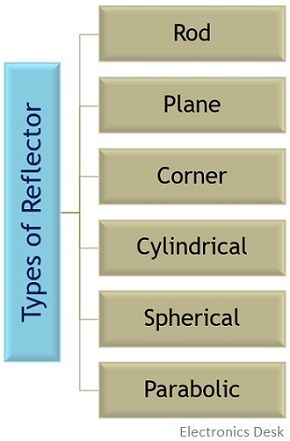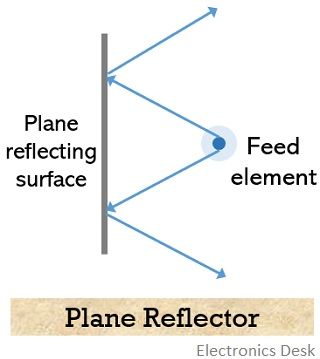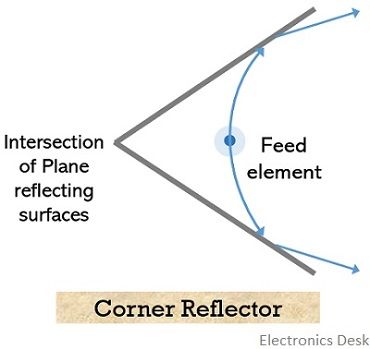Antennas that are designed to reflect the incident electromagnetic waves originating from a separate source are known as reflector antennas. It is designed to operate at high microwave frequency.
These antennas belong to the category that offers high directionality while radiating.
Content: Reflector Antennas
Introduction
Reflector antennas hold great importance when we deal with signals operating in microwave frequency ranges. Initially, it is in use since the time electromagnetic wave propagation came into existence.
Hertz proposed the idea of electromagnetic wave propagation in the year 1888.
However, these antennas gained their major presence in radar systems at the time of World War II.
Operating Principle of Reflector Antennas
We are already aware of the fact that this operates at a high range of microwave frequencies. Also, at this frequency, the electromagnetic wave behaves as a light wave. Hence, it gets reflected when strikes a polished surface.
This is the principle of operation of a reflector antenna.
However, a crucial point over here is that a reflector antenna is a combination of feed element and a reflecting surface.
This means in case of reflector antenna a reflecting surface along with an antenna element is required in order to provide excitation to the reflecting element. This means that it is composed of an active and a passive element.
The antenna that is used to provide excitation is known as the active element. While the one that re-radiates the energy emitted by the active element is the passive element which is nothing but the reflecting surface.
So, simply we can infer that the feed is the active element while the reflector is the passive element.
Generally, dipole, horn or slot antennas are used as the active elements for providing excitation to the reflector antenna. Sometimes the active element is also known as the primary antenna whereas the passive element is called the secondary antenna.
- Reflector antenna plays a very crucial role in radio wave propagation as it modifies the radiation pattern of the radiating elements.
It operates in a way that energy from the feed is directed towards the reflecting surface placed at an appropriate position. The reflector on gaining the energy further guides it in a particular direction.
The radiation pattern of the feed is referred as a primary pattern but that originating from the reflector is referred as a secondary pattern.
It is to be noted here that high gain antennas operating at microwave frequencies possess such a small physical size that reflector of any suitable shape provides the desired directivity.
Despite offering multiple geometrical configurations, there are some popular shapes in which the reflecting surface of the antenna is formed. And on this basis, the reflector antennas are further classified.
Types of Reflectors
Depending on the geometrical shape possessed by the reflecting surface, the reflector antennas are classified into the following categories:
- Rod Reflector: As the name indicates this type of reflector possesses the shape of a rod. A rod type of reflector is the one which is majorly used in Yagi-Uda antenna. The reflector is located at a certain distance behind the driven element in that antenna arrangement and has a length generally more than the length of the driven element i.e., half-wave dipole.
Here the reflector offers inductive reactance so guides the field radiated in the backward direction towards the driven element to reduce the losses due to back-reflected wave. Hence, helps to improve the gain.
It does not serve as an active member of the structure but is a parasitic element.
However, it causes variation in the impedance of the driven element. These types of reflectors exhibit frequency sensitive characteristics.
- Plane Reflector: It is also referred as flat sheet reflector and is regarded as one of the simplest reflectors that direct the electromagnetic wave in the appropriate direction.
It is nothing but a plane metallic sheet that is located at a certain distance from the feed. For the incoming radio waves, it acts as a plane mirror and allows them to undergo reflection through it.
It is to be noted that a plane reflector possesses difficulty in collimating the overall energy in the forward direction.
Thus, to handle the impedance, pattern characteristics, gain and directivity of the system, the polarization of the active element along with its position in reference to the reflecting surface is used.
- Corner Reflector: It is regarded as a modified version of the plane reflector so as to guide most of the radiation in the forward direction. Basically, the shape of a plane reflector is changed by joining two flat sheets in order to form a corner. There can also be three mutually perpendicular conducting plane surfaces.

These are basically used to enhance the directing ability of electromagnetic energy in the forward direction so as to reduce the percentage of the back-reflected wave.
- Cylindrical Reflector: This reflector is designed from a cylindrical structure thus is named so. It is another classification of structure in which a reflector is designed. Thus is nothing but a part of the cylindrical structure. Generally, cylinders are present in parabolic shapes however, other shapes are also present that can be used in its construction.
- Spherical Reflector: Like a cylindrical reflector, a spherical reflector is the one designed from a spherical surface. This means these reflectors are part of spherical surfaces and are used for collimating the energy from the active elements towards the forward direction.
- Parabolic Reflector: The type of reflector designed in the structure of a paraboloid employing the properties of a parabola is known as a parabolic reflector. The active element is present focusing the main axis, this leads to reflecting the radiated wave in the direction parallel to the main axis.
This gives rise to a small percentage of minor lobes hence the directivity is improved.
In this reflector, the generally pyramidal or conical horn antenna is used as the feed element.
Applications of Reflector Antennas
These antennas are a major part of communication and radar systems. From point to point communication, TV signal broadcasting to satellite communication these antennas are widely used. Along with these, the other applications of reflector antennas involve weather radar and radio astronomy as well as in spacecraft systems.